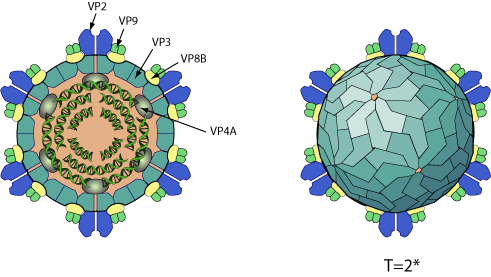Oryzavirus (taxid:10992)
VIRION

Non enveloped, icosahedral virion with a double capsid structure, about 70 nm in diameter. Pentameric turrets (VP2) sit on the outside of the innermost capsid (VP3). Each turret is surrounded by five peripheral trimers (VP9) and each trimer binds to three clamp proteins (VP4B). The outer incomplete capsid has a T=13 icosahedral symmetry, the inner capsid a T=2* icosahedral symmetry
 .
.
GENOME
Segmented linear dsRNA genome. Contains 10 segments coding for 12 proteins. Segments size range from 1162 to 3849 bp. Genome total size is about 26 kb (RRSV).
GENE EXPRESSION
The dsRNA genome is never completely uncoated, to prevent activation of antiviral state by the cell in response to dsRNA. The viral polymerase synthesizes a capped mRNA from each dsRNA segment. This capped mRNA is translocated to the cell cytoplasm where it is translated.
ENZYMES
REPLICATION
CYTOPLASMIC
- Virus penetrates into the host cell.
- Particles are partially uncoated in endolysosomes, but not entirely, and penetrate in the cytoplasm.
- Early transcription of the dsRNA genome by viral polymerase occurs inside this sub-viral particle (naked core), so that dsRNA is never exposed to the cytoplasm.
- Full-length plus-strand transcripts from each of the dsRNA segments are synthesized. These plus-strand transcripts are used as templates for translation.
- Viral proteins and genomic RNAs aggregates in cytoplasmic viral factories.
- (+)RNAs are encapsidated in a sub-viral particle, in which they are transcribed to give RNA (-) molecules with which they become base-paired to produce dsRNA genomes.
- The capsid is assembled on the sub-viral particle.
- Mature virions are released presumably following cell death and associated breakdown of host plasma membrane.
Host-virus interaction
Suppression of host silencing-mediated antiviral defense
Rice ragged stunt virus (RRSV) Pns6 protein suppresses host cell RNA silencing
 .
.
Matching UniProtKB/Swiss-Prot entries
(all links/actions below point to uniprot.org website)11 entries grouped by protein
1 entry
Inner capsid protein VP3 (Major core capsid protein VP3)
1 entry
Movement and RNA silencing protein VP6
1 entry
RNA-directed RNA polymerase (EC 2.7.7.48)
1 entry
Structural protein VP1
1 entry
Non-structural protein VP10
1 entry
Outer capsid protein VP2
1 entry
Uncharacterized protein VP4b
1 entry
Putative minor structural protein VP5
1 entry
Microtubule-associated protein VP7
1 entry
Structural protein precursor VP8
1 entry
